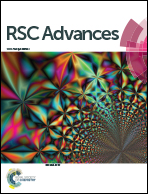Soft-templated synthesis of Mn3O4 microdandelions for the degradation of alizarin red under visible light irradiation†
Abstract
A facile wet chemical approach has been developed for the soft-templated synthesis of self-assembled Mn3O4 microdandelions through an effective dye/surfactant (viz., fluorescein isothiocyanate–dextran 2000S/cetyltrimethylammonium bromide) interaction. Addition of FITC D-2000S to an aqueous solution of CTAB results in the formation of aggregates that act as soft templates for the formation of Mn3O4 microdandelions upon addition of a weak base, diethanolamine to manganese acetate as the precursor under mild refluxing conditions. The morphology of these hybrid materials has been characterised by UV-visible, Fourier transform infrared (FTIR) and energy dispersive X-ray (EDX) spectroscopy, high resolution transmission electron microscopy (HRTEM), scanning electron microscopy (SEM), X-ray diffraction (XRD) technique, selected area electron diffraction (SAED) pattern and thermogravimetric analysis (TGA). The surface area of the microdandelions has been determined by Brunauer–Emmett–Teller (BET) analysis. The Mn3O4 microdandelions, bearing high surface area, exhibit potential photocatalytic activity towards the degradation of dye, viz., alizarin red under visible light irradiation under ambient conditions.


 Please wait while we load your content...
Please wait while we load your content...